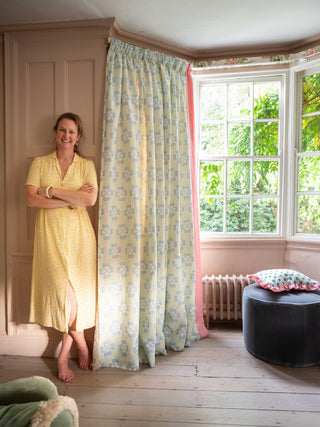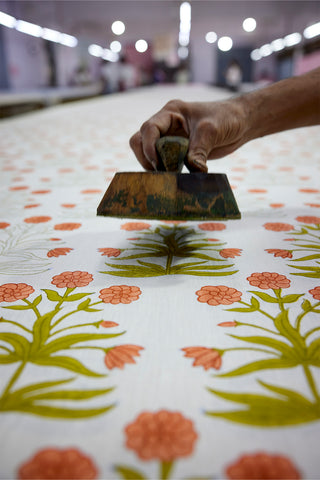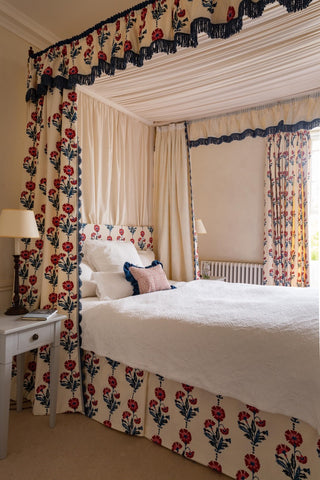When I was a child, the very first thing I saved up for and bought with my own money was an Indian quilt. My mum used to buy all her clothes from East on Guildford High Street, and I vividly remember my sisters and I sitting amongst the paisley quilts while she tried things on. I completely fell in love with a gorgeous red and orange one, and eventually managed to buy it - to this day, it sits in pride of place on my childhood bed at my parents’ house, and very much inspired the quilts that we make now. In fact, quilts were one of the very first things I made for my label.

As a child, my love of quilts was based on pure instinct - I just adored the whole soft, squishy package of comfort, pattern and colour. Now though, I’m better versed in the incredible craftsmanship that goes into making a traditional handmade quilt. I even have on my bedside table a book called Jaipur Quilts by Krystyna Hellström - a bit niche, admittedly! - but I love that it pays tribute to the painstaking process and layers of history behind the unique art of quilt-making.

Krystyna explains that the Jaipur quilt, or razai, is really the epitome of Rajasthani textile expertise, and has been an artisanal speciality of the Pink City for nearly 300 years. Making a quilt is a lengthy process. First, the wooden blocks for the block printing need to be carved. Then the very fine, gauzy cotton called Mulmul (which becomes the soft outer shell) needs to be handwoven and hand block printed. The freshly harvested cotton that will fill the quilt needs to be fluffed up (or carded), and then very carefully spread across the whole outer shell. It then needs to be hand-stitched into place to ensure a perfectly even coverage. Each stage is carried out by artisans using skills and tools that have been handed down through the generations.

Our new quilt collection has taken more than a year to produce, and I’m so proud that we can be part of keeping this tradition alive. I can’t wait for you to see the finished product, because the expertise and effort that goes into each and every quilt is so evident. Of course, you'll find cheaper quilts filled with pre-rolled polyester wadding, but when it comes to luxury, quality and craftsmanship, they won't compete.
As Krystyna points out, the secret to the perfect quilt lies in the carding process. Armed with their wooden fluffing bows, highly skilled women card the cotton over and over again to separate the cotton fibres and remove all the unwanted bits until only the finest fibres remain (it’s quite a sight to see this in action). Eventually, this feather-light, warmth-giving filling is then layered onto the outer shell - the lighter and more evenly filled it is, the warmer and more comfortable it is. In her book, Krystyna recounts how a young razai maker, Kadar Bux, gifted a quilt containing only 250g of carded cotton to Maharaja Madho Singh of Jaipur. The Maharaja was apparently so impressed that he gave him the title of Patel and two shops as gifts - which still exist today.

The threading - or hand-stitching the fluffed cotton onto the outer fabric - is a more visible part of the process. Some antique quilts have the most intricate, lovely patterns, such as eight-point stars, flowers, concentric circles, betel leaves, etc. With ours, we’ve gone for a simple diamond criss-cross running stitch, which again is all done by hand by expert sewists, who like to sit on the floor in their beautiful saris deftly sewing away with their friends.

Every stage of our quilt production is done by hand - they are handwoven, hand block printed, hand carded and hand stitched in Jaipur pretty much as they would have been 300 years ago; they’re easily our most intricate product. For our new quilt collection, I have designed three new prints: Geegee, which features lively trotting ponies, Posy, a sweet floral print, and Peggy, a striking leaf print. Our quilts all come with a contrasting gingham print on the reverse - that addition of bold colour and pattern is the classic Molly Mahon twist on tradition.

Although, as Krystyna notes, the craftsmanship behind quilt-making is largely taken for granted in India, their place in society is firmly acknowledged. Not only are they a part of daily life in Rajasthan, with locals still relying on them to keep them warm during the cold winter months, but for centuries they have been given as special presents to friends and family for weddings, birthdays etc. And because they just get better and softer with age, quilts are passed down the generations as family heirlooms.

Back at Deerhyrst Cottage in Sussex, we have a similar attitude to them - all the family has their own quilt in their own favourite pattern, and we literally use them all the time. In winter we throw them over our duvets as an extra layer, and when it gets hot in the summer, we like to sleep with just the quilt and a sheet underneath. They’re always being brought downstairs for snuggling on the sofa, and bundled into the car when we go on holiday to Cornwall or Scotland. As the perfect union of beauty and usefulness - as indeed we hope all our products are - we feel our quilts deserve to be part of daily family life.




